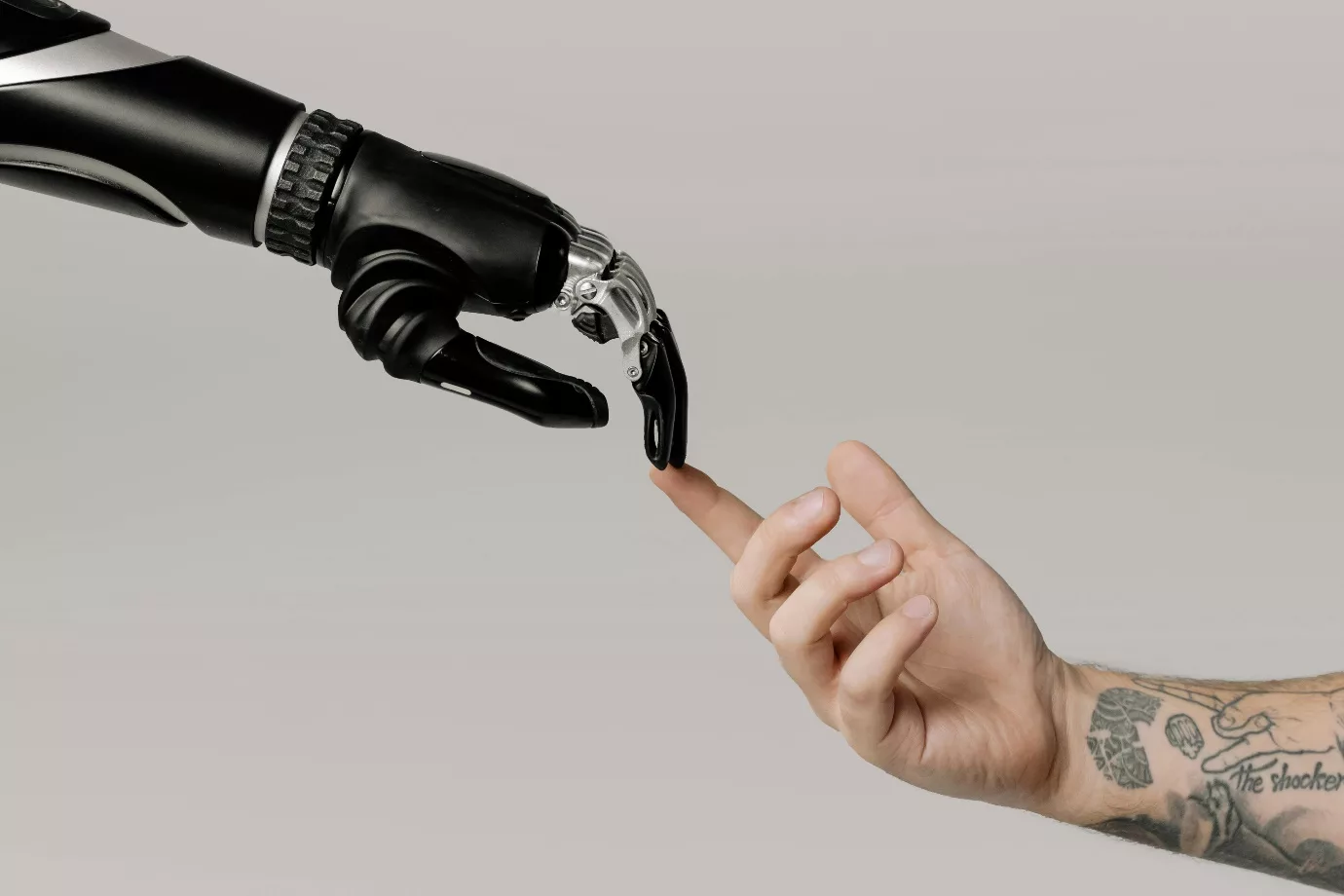
In an era where technology increasingly intersects with every aspect of our lives, the potential of Artificial Intelligence (AI) to transform various sectors isn’t just science fiction anymore–it’s reality. Within the nonprofit realm, AI is emerging as a groundbreaking tool poised to revolutionize traditional fundraising strategies. The issue for most nonprofits looking to be early adopters is how nonprofits can use AI in fundraising (and elsewhere).
In this guide, we’ll explore the role of AI in enhancing operational efficiency and donor engagement, highlighting the innovative ways in which nonprofits can leverage this technology not only to meet but exceed their fundraising goals.
As we delve into the rise of AI in the nonprofit sector, we will uncover the benefits, practical applications, and considerations of integrating AI into fundraising efforts. Plus, we’ll show you how DoJiggy augments your AI-enhanced nonprofit with new opportunities for growth and impact. Let’s begin!

Understanding AI and Its Capabilities
Are you having trouble getting a grasp of what AI is and isn’t capable of?
Don’t worry if you feel lost–AI is a rapidly evolving technology that’s still in its earliest phases of adoption. Because AI encompasses the creation of algorithms capable of performing tasks that would typically require human intelligence, it’s easy to get caught up in hype and hysteria surrounding AI.
Let’s first look at what AI’s best use cases are:
What’s AI Best Used for?
The tasks that AI is capable of span a wide array of capabilities, including:

- Understanding human language
- Recognizing complex patterns
- Making informed decisions based on data
- Learning from past experiences to improve future performance
- And much more
Leveraging AI technologies can offer transformative potential for nonprofit organizations, especially in fundraising and donor engagement.
The Rise of AI in Nonprofits
Nonprofit organizations are increasingly turning to AI technologies. Whether it is used to enhance operational efficiency or engage donors more effectively, AI enables nonprofits to allocate resources more strategically, ensuring that efforts are focused on initiatives that drive the most impact.
AI Adoption in Nonprofit Sectors
AI technology offers innovative solutions for enhancing fundraising efforts and operational efficiency across various sectors. By leveraging AI, nonprofits can unlock new potential in donor engagement, strategic planning, and overall mission effectiveness.
Here’s a detailed look at how AI is being adopted across different nonprofit sectors and some use cases to help stimulate your creativity with AI.
Healthcare Nonprofits

Healthcare nonprofits are embracing AI to enhance service delivery, improve patient outcomes, and optimize operational efficiency. Here’s how they are putting AI to work in healthcare settings:
- Data Analysis for Patient Care: Utilizing AI-driven analytics to sift through large datasets, identifying trends, predicting health crises, and crafting personalized treatment plans.
- Disease Detection and Diagnosis: Leveraging AI algorithms for the early detection and diagnosis of diseases such as cancer and diabetes, offering higher accuracy and efficiency than traditional methods.
- Telemedicine and Remote Monitoring: Implementing AI to provide remote health monitoring and telemedicine services, increasing accessibility for patients in remote or underserved areas.
- Operational Efficiency: Applying AI for operational improvements, including resource allocation, supply chain management, and the automation of administrative tasks, leading to cost reductions and enhanced efficiency.
- Research and Development: Accelerating research into new treatments and medicines by analyzing complex biological data, helping to bring advancements to market more quickly and efficiently.
Education Nonprofits
Education nonprofits are increasingly incorporating AI into their initiatives to enhance learning experiences, increase accessibility, and improve educational outcomes. Here’s a look at how AI is being used in education:

- Personalized Learning: AI algorithms analyze student performance data to tailor educational content and instruction to individual learning styles and needs, fostering a more personalized learning experience.
- Automated Administrative Tasks: Implementing AI tools to automate time-consuming administrative tasks, such as grading and attendance tracking, allowing educators more time to focus on teaching and student engagement.
- Language Learning: Utilizing AI-powered language learning apps and platforms to provide students with personalized feedback and immersive language practice, enhancing language acquisition and proficiency.
- Educational Content Creation: AI assists in developing and curating educational content, making it easier to update materials and adapt them to different learning levels and subjects.
- Accessibility and Inclusion: Leveraging AI to create adaptive learning technologies that support students with disabilities, offering tools like speech-to-text, text-to-speech, and personalized learning plans to ensure all learners have equal access to education.
- Data-Driven Insights: Using AI to analyze educational data, providing insights into student learning patterns, identifying areas for improvement, and informing policy and program decisions to optimize educational outcomes.
- Engagement and Motivation: Employing AI-driven games and interactive simulations to increase student engagement and motivation, making learning more interactive and enjoyable.
Environmental Nonprofits
Environmental nonprofits are leveraging AI to combat climate change, protect ecosystems, and promote sustainability. Here’s how AI is facilitating their efforts for the environment:

- Climate Change Analysis and Prediction: AI models analyze climate data to predict future climate conditions, helping organizations plan for and mitigate the impacts of climate change.
- Pollution Monitoring and Control: Utilizing AI to monitor air and water quality in real time, identifying sources of pollution and enabling swift action to prevent environmental degradation.
- Resource Management: AI assists in the efficient management of natural resources, such as water and forests, optimizing usage and conservation strategies to ensure sustainability.
- Renewable Energy Optimization: Leveraging AI to improve the efficiency of renewable energy sources, such as wind and solar power, by predicting energy production and optimizing grid distribution.
- Wildlife Conservation: AI technologies are used to monitor endangered species and their habitats, aiding in conservation efforts and the fight against illegal wildlife trafficking.
- Waste Reduction: Implementing AI in waste management to enhance recycling processes, reduce landfill waste, and identify opportunities for upcycling materials.
- Sustainable Agriculture: AI-driven tools support sustainable farming practices by optimizing crop yields, reducing the use of water and pesticides, and predicting agricultural trends.
Through these applications, environmental nonprofits are using AI to create more effective and scalable solutions to some of the world’s most pressing environmental challenges.
Human Rights Nonprofits
Human rights nonprofits are embracing AI to protect and promote human rights globally. Here’s how AI is being applied:

- Monitoring and Reporting Violations: AI tools analyze vast amounts of data from social media, news, and satellite images to identify and report human rights violations, enhancing accountability.
- Refugee Assistance: Leveraging AI to improve the delivery of aid to refugees, including optimizing distribution networks for food and supplies and providing personalized legal and medical advice through AI chatbots.
- Trafficking Prevention: AI algorithms are used to detect patterns indicative of human trafficking in online data and financial transactions, aiding in the prevention and investigation of trafficking activities.
- Access to Justice: Implementing AI in legal aid platforms to provide marginalized communities with access to legal information and assistance, helping them understand and assert their rights.
- Education and Awareness: AI-driven platforms offer personalized learning experiences about human rights, fostering awareness and advocacy among the global population.
- Censorship Detection: Utilizing AI to monitor and detect instances of censorship and internet shutdowns, supporting freedom of expression and access to information.
- Disaster Response and Preparedness: AI models predict the impact of natural disasters and conflicts on human populations, enabling better preparedness and targeted responses to protect vulnerable communities.
Through the strategic use of AI, human rights nonprofits are enhancing their capabilities to detect, report, and respond to human rights challenges, providing crucial support to those in need across the globe.
Animal Welfare Nonprofits
Animal welfare nonprofits are adopting AI to advance their missions, improve the care of animals, and enhance conservation efforts. Here’s how AI is making an impact for shelters and animal rescue groups:

- Tracking and Monitoring: AI technologies are used to track wildlife, monitor habitats, and study animal behaviors in real time, aiding in the conservation of endangered species and the maintenance of biodiversity.
- Disease Detection and Health Monitoring: Leveraging AI in the early detection of diseases in animals, both in the wild and in shelters, allowing for timely interventions and treatments to improve health outcomes.
- Rescue Operations: AI-driven tools assist in rescue operations by analyzing data from drones and satellites to locate lost, injured, or endangered animals in remote or inaccessible areas.
- Adoption Matching: Implementing AI algorithms to match pets with potential adopters based on compatibility, lifestyle, and behavioral traits, increasing the likelihood of successful and lasting adoptions.
- Behavioral Studies: Utilizing AI to analyze animal behaviors, helping researchers and caregivers understand stress triggers, social dynamics, and welfare needs, leading to better care practices.
- Habitat Protection: AI models predict changes in habitats and climate effects on specific species, aiding in the creation of effective conservation strategies and protected area management.
- Anti-Poaching Efforts: Employing AI to analyze data from surveillance cameras and sensors in real-time to detect poaching activities, enabling rapid response to protect endangered animals.
Arts and Culture Nonprofits
Arts and Culture nonprofits are AI into their operations and programming to preserve cultural heritage, enhance artistic creation, and engage audiences in innovative ways. Here’s how AI is being applied:

- Digital Archiving and Restoration: AI tools are used to digitize and restore historical artifacts, artworks, and cultural texts, making them more accessible to the public and preserving them for future generations.
- Interactive Exhibits and Virtual Tours: Leveraging AI to create interactive exhibits and virtual tours, providing a personalized and immersive experience for visitors, regardless of their physical location.
- Audience Engagement and Analysis: AI algorithms analyze visitor data to understand preferences and behaviors, helping museums and cultural institutions tailor their offerings and marketing strategies to enhance audience engagement.
- Artistic Creation and Collaboration: AI is being used as a tool for artistic creation, offering new mediums and methods for artists to explore and collaborate, resulting in unique artworks that blend human creativity with AI innovation.
- Cultural Data Analysis: Utilizing AI to analyze cultural trends, historical data, and social media to gain insights into cultural impacts, inform programming decisions, and predict future trends in the arts.
- Language Preservation: Implementing AI in the preservation of endangered languages by creating databases, translation tools, and educational resources, contributing to the safeguarding of global linguistic diversity.
- Accessibility Improvements: AI-driven tools enhance accessibility for people with disabilities at arts and culture venues, including real-time captioning, audio descriptions, and personalized navigation aids, ensuring inclusive experiences for all visitors.
List of Technology Used in AI
The term “AI” is often broadly used to describe complex machine learning algorithms, which can create misunderstandings about its capabilities. Making things more complicated, each of the most widely-used types of AI–such as ChatGPT, Gemini, Zapier, and Jasper– use machine learning algorithms for different usages.
For example, Zapier can be used to automate repetitive tasks between DoJiggy and other apps, whereas ChatGPT can generate an email campaign to contact donors during the holiday season.
To make it simpler, the list below shows how the AI technologies behind the branding are utilized in the nonprofit sector, specifically focusing on AI for fundraising:

- Natural Language Processing (NLP):
- Chatbots and virtual assistants for real-time communication with donors and volunteers, providing instant responses to inquiries and facilitating engagement without the need for human staff.
- Sentiment analysis tools to gauge public perception and emotional responses to campaigns or social issues, allowing for more tailored communication strategies.
- Pattern Recognition:
- Image and voice recognition systems that can automate the sorting and categorization of multimedia content, enhancing the management of digital assets.
- Fraud detection algorithms that identify suspicious activities in donation transactions, securing financial operations and donor trust.
- Predictive Analytics:
- Machine learning algorithms that analyze historical fundraising data to forecast future trends, enabling more strategic planning of fundraising campaigns.
- Donor segmentation tools that utilize AI to classify donors based on their behavior and preferences, leading to more personalized and effective outreach efforts.
- Decision Making:
- AI-driven analytics platforms that provide actionable insights for decision-makers, supporting more informed strategy development in fundraising and resource allocation.
- Automated recommendation systems that suggest the best channels and methods for reaching potential donors, optimizing marketing efforts for maximum impact.
- Automation and Efficiency:
- Process automation tools like Zapier that handle repetitive administrative tasks, freeing up human resources for higher-value tasks.
Misconceptions about the Capabilities of AI
To provide a balanced perspective on the integration and impact of Artificial Intelligence (AI), it’s important to acknowledge the important truth: AI is not a panacea for all technological and operational challenges.
While AI and its subset, machine learning, have significantly advanced automation and data processing, these technologies are not without their flaws and limitations. For instance, AI systems like ChatGPT are prone to errors, especially when faced with scenarios or data patterns not encountered during their training phase. This can lead to unexpected, even crazy, outcomes in tasks they perform. Additionally, the quest for full automation can produce results that lead to discomfort or mistrust among users.
While AI has the potential to revolutionize numerous sectors by automating complex tasks and analyzing massive datasets, it’s crucial to remember its current limitations. Understanding these challenges is essential for developing more effective and reliable AI systems in the future.
That being said, let’s consider the benefits of AI for nonprofits with an open mind and harness the possibilities of this emerging tech.

Practical Benefits of AI in Nonprofit Fundraising
The following are the most practical benefits of using AI in a nonprofit.
Chatbots for Quick Answers
Imagine a computer program that can chat with people who want to help or learn more about a cause. It can answer their questions any time of the day without needing a person to do it.
Understanding Feelings
AI can look at what people are saying online to figure out how they feel about certain topics. This helps nonprofits know the best way to talk to people about their causes.
Seeing Trends
AI can look at past events to guess what might happen in the future. This means nonprofits can plan better fundraising events because they have a good idea of what to expect.
Knowing Donors Better
AI can help sort donors into groups based on what they like or how they behave. This way, nonprofits can make their messages more personal and interesting to each donor.
Helping Decide What to Do
AI can sift through a lot of information and suggest the best actions to take. This helps nonprofits make smarter choices about how to raise money and where to spend it.
Doing Routine Tasks
AI can also take care of day-to-day jobs that are boring or take a lot of time. This frees up people to work on more important things.
Challenges and Considerations Using AI in Nonprofits
So, let’s be clear: AI is revolutionizing the nonprofit and fundraising sectors. However, there are key considerations that must be addressed. These encompass ethical concerns, data privacy and security, technical hurdles, and unforeseen issues from an emerging technology.
Here’s a cheat sheet on possible AI issues:
Ethical Considerations
- Bias: Ensure AI tools are fair and unbiased.
- Transparency: Choose AI solutions that explain their decision-making process.
Data Privacy
- Donor Privacy: Implement strict data protection for donor information.
- Consent: Be transparent with donors about how their data is used.
Technical Hurdles
- Adaptation: Staff may require training to effectively use AI technologies.
- Compatibility: AI tech may clash with legacy programs/apps/processes.

Getting Started with AI in Your Nonprofit
Integrating AI into your nonprofit’s operations, especially in the realm of fundraising, can seem daunting. In truth, approaching AI integration thoughtfully and strategically, nonprofits can leverage AI to enhance organizational effectiveness and reach.
Here’s how to begin integrating AI in fundraising and choosing the right AI tools for your nonprofit.
Define Clear Objectives
- Identify Specific Needs: Understand the particular challenges or opportunities within your fundraising efforts that AI can address. This could range from automating donor communications to analyzing giving patterns to predict future donations.
- Set Achievable Goals: Establish clear, measurable objectives for what you hope to achieve by integrating AI. Whether it’s increasing donor engagement, personalizing fundraising campaigns, or streamlining administrative processes, having defined goals will guide your AI integration efforts.

Start Small
- Pilot Projects: Begin with small-scale projects to test the waters. This allows you to experiment with AI solutions without overcommitting resources and provides a learning opportunity for your team. For instance, implementing a chatbot for answering frequently asked questions on your donation page can be a good start.
- Evaluate and Scale: Use the insights and outcomes from your pilot projects to refine your approach and gradually expand the use of AI in your fundraising strategies.
Choose the Right AI Tools and Partners
- Assess Compatibility: Look for AI tools and solutions that not only align with your specific goals but also integrate smoothly with your existing systems and workflows.
- Vendor Research: Invest time in researching potential AI partners. Consider vendors with proven experience in the nonprofit sector and those offering solutions specifically designed for fundraising needs.
- Consider Ethical Implications: Select tools and partners that prioritize ethical AI use, ensuring that the solutions respect data privacy and are free from bias.
- Seek Support: Engage with vendors that offer robust support and training options. This is crucial for navigating the initial learning curve and ensuring your team can effectively utilize the AI tools.
Foster Organizational Buy-In

- Educate Your Team: Provide your staff with resources and training on the benefits and uses of AI in fundraising. Understanding AI’s potential impact on your operations can foster support across your organization.
- Collaborative Approach: Involve key team members in the decision-making process when selecting AI tools and designing AI-powered projects. This ensures that the solutions chosen meet the needs and capabilities of your team.
By starting with clear objectives, embracing small-scale projects, carefully selecting AI tools and partners, and fostering organizational buy-in, your nonprofit can successfully integrate AI into its fundraising strategy. This thoughtful approach will allow you to unlock the potential of AI, driving efficiency and innovation in your fundraising efforts.
Do More with DoJiggy
Looking to elevate your nonprofit’s fundraising efforts with streamlined processes and integrate AI into your nonprofit? DoJiggy has you covered.
Our suite of tools is designed to simplify and enhance every aspect of your fundraising activities–including AI integrations for nonprofits. Through our integration with Zapier, more features and functionality are easily automated. Discover how DoJiggy can support your organization in managing donors, personalizing communication, planning events, and making informed fundraising predictions.
Here’s what we offer.

Donor Management
Our platform enables efficient management of donor information, making it easier for you to understand and segment your audience. By streamlining this process, you can focus your efforts on crafting fundraising campaigns that resonate with your donor base, enhancing overall effectiveness.
Personalized Communication
With DoJiggy’s integrations to Mailchimp and other advanced email marketing systems, personalizing communication is straightforward. Find tools to support targeted marketing campaigns, allowing you to reach out to different segments of your donor base with messages that speak directly to their interests and motivations, fostering deeper engagement.
Event Planning
Organizing fundraising events is a breeze with DoJiggy. Our platform offers features that simplify logistics, from registration and ticketing to attendee engagement, ensuring every event runs smoothly and makes the right impact.
Fundraising Analysis and Predictions
DoJiggy integrates with Google Analytics for robust reporting and analytics tools that help you analyze past performance and make informed decisions for future campaigns. Understanding these fundraising trends and outcomes has never been easier, empowering you to plan strategically and achieve your goals.
Conclusions on Working with AI
In conclusion, AI presents a transformative opportunity for nonprofits willing to innovate their fundraising strategies. By embracing AI early, nonprofits can enhance efficiency, deepen donor engagement, and drive greater impact.
Combining artificial intelligence with DoJiggy’s fundraising platform means nonprofits can scale their operations like never before. DoJiggy’s comprehensive suite of features ensures your event is not just successful but memorable and impactful. Plus, DoJiggy already integrates with automation AI tools like Zapier–giving you a greater impact in today’s nonprofit landscape.

Explore DoJiggy’s Resources and Get Started
By leveraging DoJiggy’s tools and resources, you’re not just planning an event but creating an experience that resonates, engages, and succeeds. Start your journey to a memorable and impactful event today!



